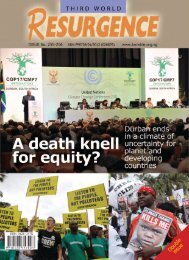Plantations, poverty and power - Critical Information Collective
Plantations, poverty and power - Critical Information Collective
Plantations, poverty and power - Critical Information Collective
Create successful ePaper yourself
Turn your PDF publications into a flip-book with our unique Google optimized e-Paper software.
96<br />
plantations. In fact 6,100 hectares were planted. The cost of establishing the plantations was far higher<br />
than expected, because of “the cost of settling disputes over the l<strong>and</strong> for the plantations” according to<br />
Alastair Fraser, an ADB consultant. 488<br />
Bangladesh<br />
A US$46.8 million afforestation project in Bangladesh resulted in the establishment of 20,000 hectares of<br />
plantations between 1989 <strong>and</strong> 1996. The Bank’s Project Performance Audit Report notes that “Tree<br />
planting was successful, <strong>and</strong> tree survival rates during establishment were generally high.” However, the<br />
report points out, the project was largely a “tree planting exercise, without yielding significant benefits”.<br />
Villagers who took part in the project, “received only minimal benefits”. The result was “impatience <strong>and</strong><br />
a feeling of resignation among participants” <strong>and</strong> “a potentially hostile social environment.” 489 Under the<br />
project, the Forestry Department had “confiscated l<strong>and</strong>s from the locals without giving any compensation,<br />
destroyed st<strong>and</strong>ing crops <strong>and</strong> ignored protests of genuine l<strong>and</strong>holders”, notes the Asian Indigenous &<br />
Tribal Peoples Network (AITPN). L<strong>and</strong> was taken without compensation. When villagers protested in<br />
1994, forest guards opened fire, injuring seven people. 490<br />
An earlier ADB-financed “community forestry project” in Bangladesh included fuelwood plantations as<br />
the largest project component. These “fell short of optimum growth” <strong>and</strong> some plantations “were<br />
damaged by encroachment”. 491<br />
The ADB also funded a Forestry Master Plan for Bangladesh under the Tropical Forestry Action Plan.<br />
The Forestry Master Plan proposed an “Integrated Forest Project”, which would have resulted in vast<br />
areas of l<strong>and</strong> being planted with trees. The aim was to increase tree cover in Bangladesh from about 8 per<br />
cent to 20 per cent. AITPN points out that had proposal been implemented it would have been a disaster,<br />
resulting in lost agricultural l<strong>and</strong>, reduced food production <strong>and</strong> serious problems for indigenous<br />
communities. 492<br />
The ADB also supported the Chittagong Hill Tracts Development Board which effectively allowed<br />
increased government <strong>and</strong> Bengali control over the indigenous Jumma people. Hill people were forcibly<br />
resettled into farms <strong>and</strong> under a scheme aimed at ending shifting cultivation. In effect, control of the<br />
forest was taken from indigenous communities <strong>and</strong> h<strong>and</strong>ed over to the state. The ADB’s loans to the<br />
project “support <strong>and</strong> sustain the conflict until today”, notes AITPN. 493<br />
488 Alastair Fraser (2000) “The Role of Financial/Banking Institutions in Timber Plantation Development”, Proceedings<br />
of the International Conference on Timber Plantation Development, Manila, Philippines, 7-9 November 2000.<br />
489 “Project Performance Audit Report on the Upazila Afforestation <strong>and</strong> Nursery Development Project (Loan 956-<br />
BAN[SF]) in Bangladesh”, Asian Development Bank, September 2001.<br />
490 “ADB Programs in Forestry Sector in Bangladesh: Identifying <strong>Critical</strong> Issues for Changes in ADB policy”,<br />
presentation by the Asian Indigenous & Tribal Peoples Network at the Indigenous Peoples Forum, 33rd Annual Meeting of<br />
the Board of Governors, Asian Development Bank, Chiang Mai, Thail<strong>and</strong>, 4-8 May 2000.<br />
491 “Sector synthesis of post-evaluation findings in the forestry sector”, Asian Development Bank, Post-Evaluation<br />
Office, August 1994.<br />
492 “ADB Programs in Forestry Sector in Bangladesh: Identifying <strong>Critical</strong> Issues for Changes in ADB policy”,<br />
presentation by the Asian Indigenous & Tribal Peoples Network at the Indigenous Peoples Forum, 33rd Annual Meeting of<br />
the Board of Governors, Asian Development Bank, Chiang Mai, Thail<strong>and</strong>, 4-8 May 2000.<br />
493 “ADB Programs in Forestry Sector in Bangladesh: Identifying <strong>Critical</strong> Issues for Changes in ADB policy”,<br />
presentation by the Asian Indigenous & Tribal Peoples Network at the Indigenous Peoples Forum, 33rd Annual Meeting of<br />
the Board of Governors, Asian Development Bank, Chiang Mai, Thail<strong>and</strong>, 4-8 May 2000.















